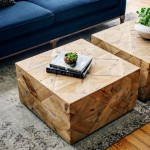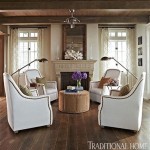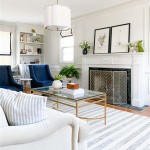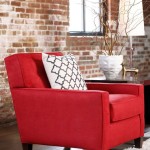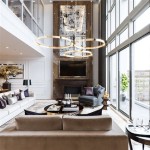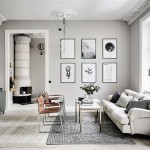Rustic Contemporary Living Room Ideas: Blending Warmth and Modernity
The rustic contemporary living room represents a harmonious fusion of two seemingly disparate design aesthetics. It combines the raw, natural textures and comforting warmth of rustic design with the clean lines, minimalist principles, and sophisticated elements of contemporary style. The result is a space that feels both inviting and refined, offering a comfortable and stylish environment for relaxation and socializing. Successfully implementing this style requires careful consideration of color palettes, materials, furniture choices, and decorative accents. This article will explore key aspects of creating a captivating rustic contemporary living room.
Understanding the Core Elements of Rustic Contemporary Design
At its core, rustic contemporary design is about balance. It's not about simply placing rustic elements in a modern space or vice versa. It’s about thoughtfully integrating both styles to create a cohesive and visually appealing environment. This integration requires a deep understanding of the characteristics of each individual style.
Rustic design emphasizes natural materials like wood, stone, and leather. The textures are often rough and unrefined, showcasing the inherent beauty of these materials. Warm, earthy color palettes are prevalent, drawing inspiration from the outdoors. Think of browns, greens, creams, and rusty reds. Comfort and functionality are paramount, with furniture designed for relaxation and family gatherings.
Contemporary design, on the other hand, prioritizes clean lines, geometric shapes, and a minimalist aesthetic. Color palettes tend to be more neutral, often featuring grays, whites, and blacks, with the occasional pop of color used strategically as an accent. Materials like metal, glass, and concrete are frequently incorporated to create a sense of modernity and sophistication. Form often follows function, with furniture designed for both aesthetics and practicality.
The key to blending these styles lies in identifying their shared values – comfort, functionality, and an appreciation for quality materials – and using these common threads to create a unified design. For example, a contemporary sofa with clean lines can be upholstered in distressed leather, bridging the gap between the two styles. A sleek metal coffee table can be placed on a natural fiber rug, creating a visually interesting contrast.
Key Considerations for Material Selection
The selection of materials is crucial to achieving a successful rustic contemporary living room. The focus should be on incorporating natural, high-quality materials while maintaining a sense of modernity and sophistication. A careful balance of textures and finishes is essential to prevent the space from feeling either too rustic or too sterile.
Wood: Wood is a cornerstone of rustic design, and it plays a significant role in rustic contemporary interiors. Choose wood with visible grain and knots to showcase its natural character. Reclaimed wood is an excellent option, adding a sense of history and sustainability to the space. Consider using wood for flooring, accent walls, exposed beams, and furniture. However, avoid overly ornate or heavily carved wood pieces, as these tend to lean more towards traditional rustic styles.
Stone: Stone is another natural material that adds texture and visual interest to a rustic contemporary living room. Stone fireplaces, accent walls, or even coffee tables can create a focal point and bring a sense of the outdoors inside. Natural stone, such as slate, granite, or limestone, are all excellent choices. If using stone, consider its color and texture in relation to other materials in the room. Lighter-colored stone can create a brighter, more modern feel, while darker stone can add a sense of drama and warmth.
Metal: Metal adds a touch of contemporary sophistication to the rustic aesthetic. Use metal accents sparingly to avoid overpowering the space. Consider metal lighting fixtures, coffee table legs, or decorative accessories. Black metal is a popular choice, providing a strong contrast to the natural wood and stone elements. Brass or copper accents can also add warmth and visual interest. Avoid overly polished or shiny metals, as these can feel out of place in a rustic environment. Brushed or matte finishes are generally more suitable.
Leather: Leather is a luxurious and durable material that adds warmth and texture to a rustic contemporary living room. Leather sofas, armchairs, and ottomans are all excellent choices. Choose leather in natural tones, such as brown, tan, or gray, to complement the earthy color palette. Distressed leather adds a sense of age and character, enhancing the rustic appeal. Consider the type of leather you choose; full-grain leather is the highest quality and will develop a beautiful patina over time.
Textiles: Incorporate natural textiles, such as wool, linen, and cotton, to add softness and comfort to the space. Use these textiles for curtains, rugs, throw pillows, and blankets. Chunky knit throws and textured rugs can add visual interest and warmth. Avoid overly synthetic or shiny fabrics, as these can detract from the natural aesthetic. Consider the weight and texture of the textiles you choose; heavier fabrics can add a sense of coziness, while lighter fabrics can create a more airy and open feel.
Designing the Layout and Furniture Selection
The layout and furniture selection are crucial to creating a functional and aesthetically pleasing rustic contemporary living room. The space should be designed to promote comfort, conversation, and relaxation. Consider the size and shape of the room when planning the layout and choosing furniture. Avoid overcrowding the space, and focus on creating a sense of flow and balance.
Seating Arrangement: The seating arrangement should be designed to facilitate conversation and create a comfortable gathering space. A common approach is to arrange seating around a central focal point, such as a fireplace or coffee table. A large sofa is a great starting point, providing ample seating for family and guests. Complement the sofa with armchairs, ottomans, or accent chairs to create a more varied and dynamic seating arrangement. Consider the style of the seating; clean lines and simple silhouettes are essential for maintaining a contemporary feel.
Coffee Tables: The coffee table is a key element in any living room, providing a surface for drinks, books, and other items. Choose a coffee table that complements the overall style of the room. A wooden coffee table with metal legs can be a great option, combining rustic and contemporary elements. A stone-topped coffee table can also add visual interest and texture. Consider the size and shape of the coffee table in relation to the seating arrangement; it should be easily accessible from all seating areas.
Lighting: Lighting plays a crucial role in creating the desired ambiance in a rustic contemporary living room. Incorporate a mix of natural and artificial light to create a warm and inviting atmosphere. Large windows are ideal for maximizing natural light. Supplement natural light with a variety of artificial lighting sources, such as overhead lighting, floor lamps, and table lamps. Choose lighting fixtures that complement the overall style of the room. Metal pendant lights or sconces can add a touch of contemporary sophistication. Avoid overly bright or harsh lighting; opt for warm, soft lighting that creates a cozy and relaxing atmosphere.
Storage: Storage is essential for keeping a living room organized and clutter-free. Incorporate storage solutions that blend seamlessly with the overall design. Wooden shelves or cabinets can provide ample storage space while adding a rustic touch. Consider using baskets or bins to store smaller items. Avoid overly ornate or bulky storage furniture, as these can detract from the contemporary aesthetic. Floating shelves are a great option for creating a minimalist and modern storage solution.
Rugs: Rugs are essential for defining the seating area and adding warmth and texture to the floor. Choose a rug that complements the overall color palette and style of the room. Natural fiber rugs, such as jute or sisal, are a great option for adding a rustic touch. Wool rugs can also add warmth and softness. Consider the size of the rug in relation to the seating arrangement; it should be large enough to anchor the furniture and create a cohesive space. Avoid overly patterned or colorful rugs, as these can detract from the overall aesthetic.
By carefully considering these key aspects – understanding the core elements, material selection, and layout and furniture selection – one can successfully create a rustic contemporary living room that is both stylish and inviting. The key is to strike a balance between the raw, natural textures of rustic design and the clean lines and minimalist principles of contemporary style.

41 Best Rustic Living Room Ideas Decor For Rooms

Embrace Natural 24 Rustic Living Room Decor Ideas Rugs Direct

Rustic Decor Style Enlighting Your Mid Century Living Room Ambience

Before After Contemporary Rustic Living And Dining Room Decorilla Online Interior Design

48 Rustic Living Room Ideas For A Cozy Inviting Family Space

30 Rustic Living Room Ideas For A Cozy Organic Home Decoist

32 Best Rustic Interior Design Ideas In 2024 Decorilla Online

75 Rustic Open Concept Living Room Ideas You Ll Love July 2025 Houzz

What Is A Modern Rustic Home And 25 Examples Digsdigs

41 Rustic Farmhouse Living Room Ideas For A Cozy Space

